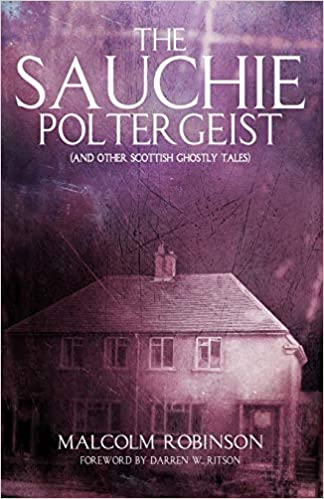
Reviewed by Ted Dixon
Before reading this book, I knew of Malcolm Robinson only from the link to one of his articles (i.e. Robinson, 2014) at the end of the Psi Encyclopedia entry on the Sauchie case, based on A.R.G. Owen’s (1964) ‘Can We Explain the Poltergeist?’ This Encyclopedia entry now mentions Malcolm’s book, independently published, as well.
Having now read the book, I am glad I have done so but this is mainly because Sauchie was the first purportedly true story of a poltergeist I came across – as a London student in the early 60s, in a two-page spread in the Daily Mirror while waiting my turn at the barber’s. Malcolm quotes Owen as writing that “In my opinion the Sauchie case must be regarded as establishing beyond all reasonable doubt the objective reality of some poltergeist phenomena’’. I did not doubt this from the Mirror article and have never seriously doubted this since, eventually joining the SPR in 1983 and beginning to read more on the subject, not least Gauld and Cornell’s (1979) ‘Poltergeists’.
So, for me, Sauchie is perhaps something like a first love that you do not forget and enjoy thinking back on. Malcolm does not really add anything much to the evidential essentials of the Owen (and Psi Encyclopedia) account of events or to an up to date analysis of the case but, as well as telling the Sauchie story again, in his own way, he provides a lot of detailed background information including photos of the extensive coverage of events in the local press.
Even more interesting to me was his account (with transcripts of telephone calls and copies of letters) of getting in touch with some of the original witnesses and trying to find out more about the poltergeist agent Virginia Campbell’s life (before she and family moved to Sauchie and then when she moved to the Bedford area as an adult). Malcolm’s is a human interest story as much as a poltergeist story. It is also a story of Malcolm himself, of how he got into psychical research and of how this relates to and supports his own Spiritualist beliefs.
I also felt after reading the book (and following some of Malcolm’s website links) that I had got a much better idea than previously of the world of local (non-SPR) investigations by people like Malcolm and the other investigators he mentions; and, in his case at least, of their motivations and methods of working and getting publicity via TV appearances and local radio etc. For example, Malcolm includes a fascinating (and generous: everybody and everything is described as ‘lovely’) account of filming an interview with a BBC One Show TV crew.
I feel that I need to warn any potential reader that Malcolm has clearly not had the help of a profession editor in organising and polishing his text. In places it reads as if Malcolm dictated his thoughts into a machine and then left the transcript pretty much as it was, not concerned whether a full-stop might be better than a comma and so on. This detracts from readability a bit.
A final point is that as well as including an account of other Scottish ghostly tales, the book touches on Enfield and South Shields and other poltergeist cases. In the case of Enfield at least – the case Malcolm describes that I know most about – some of what he says is misleading. But in mitigation, the Enfield case is only mentioned in passing to provide historical context.
If you have just a general interest in poltergeist cases, the first port of call on Sauchie should be the Psi Encyclopedia. But if you want to read more detail on Sauchie and cannot get hold of A.R.G. Owen’s book (no longer in print) then this update by Malcolm Robinson provides it.
References
Gauld, A., & Cornell, A. D. (1979). Poltergeists. London: Routledge & Kegan Paul.
Owen, A. R. G. (1964). Can we explain the Poltergeist? New York: Garrett Publications.
Robinson, M. (2014). The Sauchie Poltergeist.
Ted Dixon can be reached at email: [email protected]

